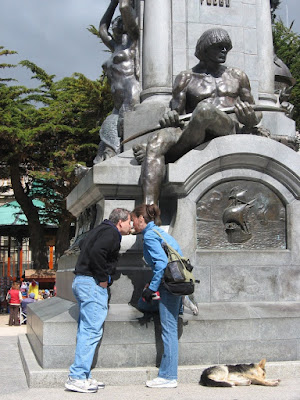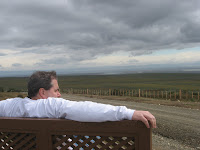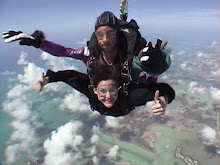 In the book Footprint Chile by Janak Jani, the author has made the following statement: "Chileans say that, when God had almost completed the act of creation, there was a little of everything left, so God threw it all down in a narrow strip of land and called it Chile. . .this is a fantastically diverse country when combined with the country's shape the geographical barriers rule out circular routes within the country - the choice therefore comes down to whether to go north or south."
In the book Footprint Chile by Janak Jani, the author has made the following statement: "Chileans say that, when God had almost completed the act of creation, there was a little of everything left, so God threw it all down in a narrow strip of land and called it Chile. . .this is a fantastically diverse country when combined with the country's shape the geographical barriers rule out circular routes within the country - the choice therefore comes down to whether to go north or south."We chose to head to the southern part of Chile - in fact the southern most city - Pu
 nta Arenas. Because of the limited access to this part of Chile, we opted for a four hour flight into this city. We checked into the bed and breakfast La Casa Escondida. This was a very nice place tucked away in the middle of a forest like setting and just a half mile from the Straits of Magellan. Pamela and Luis were the most wonderful hosts and were there to greet us upon our arrival.
nta Arenas. Because of the limited access to this part of Chile, we opted for a four hour flight into this city. We checked into the bed and breakfast La Casa Escondida. This was a very nice place tucked away in the middle of a forest like setting and just a half mile from the Straits of Magellan. Pamela and Luis were the most wonderful hosts and were there to greet us upon our arrival.We then headed into town to tour the city of Punta Arenas. In the center of the city, there is a statue of Magellan with a mermaid and two Fuegian Indians at his feet. According to local wisdom, those who kiss the big toe of one of the Indians will return to Punta Arenas. I wanted to make sure Dean and I followed in that tradition and I insisted that we kiss the Fuegian Indian's big toe. So many people touch and kiss this statue that I didn't want to take any chances - I whipped out my handiwipes and sanitized the Indian's big toe before we kissed it.

Also during our 5 day stay in Punta Arenas, we had the opportunity to see areas surrounding the city. We headed to the southern most point on the continent - Fuerte Bulnes and Punta Santa Ana. In 1843, Captain Juan Williams, the naturalist Bernardo Philippi set sail from Chiloe to the Straits of Magellan to plant the Chilean flag in this region before other powers could beat Chile to it. They chose a rocky promontory that dominated the strait and named it Fuerte Bulnes. Although the promontory was strategically appropriate for monitoring seafaring traffic, the location proved undesirable, and they pulled up the stakes and moved to Punta Arenas.


 Next we headed to Seno Otway the site of a colony of about 11,000 Magellanic penguins. It was interesting for Dean and I to learn that penguins form lifelong partnerships and divide up their chores equally. Every morning and evening the penguin couples change shifts. One heads out to fish, the other returns from fishing to take care of the young. When this changing of the guard begins, the penguins line up and waddle to and from the sea. These penguins come from Brazil from October through March to hatch and raise their young. Another interesting thing that we learned - these penguins burrow holes into the ground where they lay their eggs and raise their babies.
Next we headed to Seno Otway the site of a colony of about 11,000 Magellanic penguins. It was interesting for Dean and I to learn that penguins form lifelong partnerships and divide up their chores equally. Every morning and evening the penguin couples change shifts. One heads out to fish, the other returns from fishing to take care of the young. When this changing of the guard begins, the penguins line up and waddle to and from the sea. These penguins come from Brazil from October through March to hatch and raise their young. Another interesting thing that we learned - these penguins burrow holes into the ground where they lay their eggs and raise their babies.One day we also headed to Tierra del Fuego. We took a 20 minute ferry ride across the
 straights. The weather was so windy making this short ferry trip rather bumpy! We had Commerson's Dolphins playing in the wake of the ferry during our crossing. These dolphins were black and white and almost looked like small orcas. Our time on Tierra del Fuego we spent on the northern part of the island. We visited the town of Porvenir and we drove the circut of gold road. During the late 1800s, gold was found in the rivers close to Porvenir.
straights. The weather was so windy making this short ferry trip rather bumpy! We had Commerson's Dolphins playing in the wake of the ferry during our crossing. These dolphins were black and white and almost looked like small orcas. Our time on Tierra del Fuego we spent on the northern part of the island. We visited the town of Porvenir and we drove the circut of gold road. During the late 1800s, gold was found in the rivers close to Porvenir.  Primarily the Chileans and Croatians worked to mine the gold. The rivers never produced an amount of gold large enough to truly sustain and grow the city. Gold mining is no longer prosperous for this city. This area of the island is very useful for raising sheep. It was very funny to watch the sheep walk in the evening after feeding in the fields all day. They lined up and formed straight rows and walked back to their farm pastures. Guanaco (llamas) and rheas also roam free. The roads on the Chilean side of the island are all dirt which made driving very challenging. There were a couple of times that during our rapid efforts to get back to the ferry after having a long day of driving, that while manuvering the car, Dean "caught air" (all four tires were off the ground) as we were speeding over rough dirt roads - whew (deep sigh) I am glad we arrived back home safe that night.
Primarily the Chileans and Croatians worked to mine the gold. The rivers never produced an amount of gold large enough to truly sustain and grow the city. Gold mining is no longer prosperous for this city. This area of the island is very useful for raising sheep. It was very funny to watch the sheep walk in the evening after feeding in the fields all day. They lined up and formed straight rows and walked back to their farm pastures. Guanaco (llamas) and rheas also roam free. The roads on the Chilean side of the island are all dirt which made driving very challenging. There were a couple of times that during our rapid efforts to get back to the ferry after having a long day of driving, that while manuvering the car, Dean "caught air" (all four tires were off the ground) as we were speeding over rough dirt roads - whew (deep sigh) I am glad we arrived back home safe that night.
As we would drive around to all of these different places, the song "It's the End of the World as We Know It" kept going through my head. We were truly at the end of the world. But what a beautiful place to be! Our journey continued beyond this city - more to come...








No comments:
Post a Comment